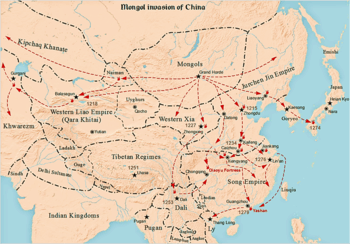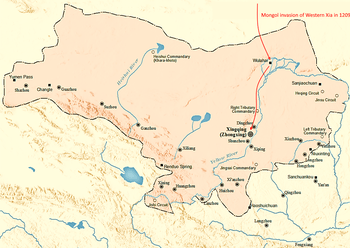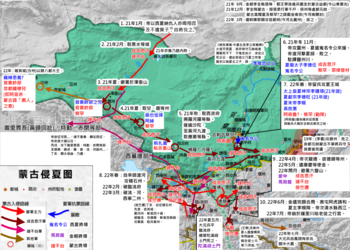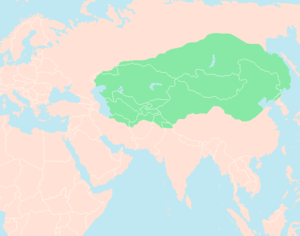Mongol conquest of Western Xia
The Mongol conquest of Western Xia was a series of conflicts between the Mongol Empire and the Western Xia dynasty. Hoping to gain both plunder and a vassal state, Mongol leader Genghis Khan commanded some initial raids against Western Xia before launching a full-scale invasion in 1209. This marked both the first major invasion conducted by Genghis into the Chinese heartland.
| Mongol conquest of Western Xia | |||||||||
|---|---|---|---|---|---|---|---|---|---|
| Part of the Mongol invasion of China | |||||||||
 Mongol conquest of Western Xia and other regimes of China | |||||||||
| |||||||||
| Belligerents | |||||||||
| Mongol Empire |
a) Western Xia b) Western Xia Jin dynasty | ||||||||
| Commanders and leaders | |||||||||
|
a) Genghis Khan b) Genghis Khan † Ögedei Khan Subutai Tolui Chagaan |
a) Emperor Huanzong (1205) b) Emperor Xianzong (1225–1226) Emperor Mozhu (1226–1227) Asha | ||||||||
| Strength | |||||||||
|
a) Total numbers unknown, over 30,000 in 1209 campaign b) 180,000 |
a) Total numbers unknown, over 270,000 in 1209 campaign b) Total numbers unknown, over 300,000 at Battle of Yellow River | ||||||||
After a nearly year-long siege of the capital, Yinchuan, although the diverted river accidentally flooded the Mongol camp, the Tangut emperor Li Anquan surrendered in January 1210. For nearly a decade the Western Xia served the Mongols as vassals and aided them in the Mongol–Jin War, but when Genghis invaded the Islamic Khwarazmian dynasty in 1219, Western Xia attempted to break away from the Empire and ally with the Jin and Song dynasties. Angered by this betrayal, in 1225 Genghis Khan sent a second, punitive expedition into Western Xia. Genghis intended to annihilate the entire Western Xia culture, and his campaign systematically destroyed Western Xia cities and the countryside, culminating in the siege of the capital in 1227 along with forays into Jin territory. Near the end of the siege, in August 1227, Genghis Khan died from an uncertain cause, though some accounts say he was killed in action against Western Xia. After his death, Yinchuan fell to the Mongols and most of its population was massacred.
Background
The Western Xia dynasty, also called Xi-Xia, the Tangut Empire, or Minya, emerged in 1038, and eventually covered what are now the northwestern Chinese provinces of Ningxia, Gansu, eastern Qinghai, northern Shaanxi, northeastern Xinjiang, southwest Inner Mongolia, and southernmost Outer Mongolia.[1][2] A fairly small state, Western Xia struggled against its larger and more powerful neighbors, the Liao dynasty to the east and northeast, and the Song dynasty to the southeast. When the Jin dynasty emerged in 1115 and displaced the Liao, Western Xia eventually accepted vassal status to the new Jin empire. Aiding Jin in their wars against the Song, Western Xia gained thousands of square miles of former Song territory. However, over many years the relations between Western Xia and Jin gradually declined.
Upon the death of its fourth ruler, Emperor Renzong, Emperor Huanzong took the throne and Western Xia's power began to fail. Though militarily inferior to the neighboring Jin, the Western Xia still exerted a significant influence upon the northern steppes. The state often welcomed deposed Kerait leaders because of close trade connections to the steppes and because of the possibility of using the refugees as pawns in the Mongolian Plateau.[3] In the late 1190s and early 1200s, Temujin, soon to be Genghis Khan, began consolidating his power in Mongolia. Following the death of the Keraites leader Ong Khan to Temujin's emerging Mongol Empire in 1203, Keriat leader Nilqa Senggum led a small band of followers into Western Xia.[3] However, after his adherents took to plundering the locals, Nilqa Senggum was expelled from Western Xia territory.[3]
Preliminary raids
Using his rival Nilga Senggum's temporary refuge in Western Xia as a pretext, Temujin launched a raid against the state in 1205 in the Edsin region.[3][4][5] The Mongols plundered border settlements and one local Western Xia noble accepted Mongol supremacy.[6] During a raid on Ganzhou (present-day Zhangye), the Mongols captured the son of the city's commander.[7] This young boy joined Mongol service and took a Mongol name, Chagaan, and eventually rose through the ranks to become commander of Temujin's personal guard.[8] The next year, 1206, Temujin was formally proclaimed Genghis Khan, ruler of all the Mongols, marking the official start of the Mongol Empire, while Li Anquan killed Huanzong of Western Xia in a coup d'état and installed himself as Emperor Xiangzong. In 1207, Genghis led another raid into Western Xia, invading the Ordo region and sacking Wuhai, the main garrison along the Yellow River, before withdrawing in 1208.[5][9] Genghis then began preparing for a full-scale invasion. By invading Western Xia, he would gain a tribute-paying vassal, and also would take control of caravan routes along the Silk Road and provide the Mongols with valuable revenue.[10] Furthermore, from Western Xia he could launch raids into the even more wealthy Jin dynasty.[11]
First invasion

In 1209, Genghis undertook his campaign to actually conquer Western Xia. Li Anquan requested aid from the Jin dynasty, but the new Jin emperor Wanyan Yongji refused to send aid, stating that "It is to our advantage when our enemies attack each other. Wherein lies the danger to us?"[12] After defeating a force led by Kao Liang-Hui outside Wulahai, Genghis captured the city and pushed up along the Yellow River, defeating several cities as he went, until he reached the fortress Kiemen which guarded the only pass through the Helan Mountains to the capital, Yinchuan.[3][13][14] Containing an army of up to 70,000, plus 50,000 reinforcements, the fortress proved too difficult to capture, and after a two-month stand-off the Mongols feinted a retreat, luring the garrison, led by Wei-ming Ling-kung, out onto the field where it was easily destroyed.[13][14] His path now open, Genghis advanced to the capital. Well fortified, Yinchuan held about 150,000 soldiers, nearly twice the size of the Mongol army.[15] One of their first endeavors at siege warfare, the Mongols lacked the proper equipment and experience to take the city. They arrived at the city in May, but by October were still unsuccessful at breaking through.[3] Genghis attempted to flood the capital by diverting the river and its network of irrigation canals into the city, and by January 1210 the walls of Yinchuan were nearly breached. However, the dike used to divert the river broke, and the ensuing flood wiped out the Mongol camp, forcing the Mongols to take higher ground.[3] Despite this setback, the Mongols still posed a threat to Western Xia, and with the state's crops destroyed and no relief coming from the Jin, Li Anquan agreed to submit to Mongol rule, demonstrating his loyalty by giving a daughter, Chaka, in marriage to Genghis and paying a tribute of camels, falcons, and textiles.[16]
Western Xia as a Mongol vassal
In 1210, Western Xia attacked the Jin dynasty as punishment for their refusal to aid them against the Mongols.[17] The following year, the Mongols joined Western Xia and began a 23-year-long campaign against Jin. The same year Li Anquan abdicated the throne, and subsequently died, after Shenzong seized power.
However, despite aiding the Mongols against Jin, in 1217 when Genghis Khan requested help for his Central Asian campaigns, Western Xia refused to commit troops, and as a warning the Mongols besieged the capital before withdrawing.[18][19] In 1219, Genghis Khan launched his campaign against the Khwarazmian dynasty in Central Asia, and requested military aid from Western Xia. However, the emperor and his military commander Asha refused to take part in the campaign, stating that if Genghis had too few troops to attack Khwarazm, then he had no claim to supreme power.[10][20] Infuriated, Genghis swore vengeance and left to invade Khwarazm, while Western Xia attempted alliances with the Jin and Song dynasties against the Mongols.[21]
Second invasion

After defeating Khwarazm in 1221, Genghis prepared his armies to punish Western Xia for their betrayal. Meanwhile, Emperor Shenzong stepped down from power in 1223, leaving his son, Xianzong, in his place. In 1225, Genghis Khan attacked with a force of approximately 180,000.[22] After taking Khara-Khoto, the Mongols began a steady advance southward. Asha, commander of the Western Xia troops, could not afford to meet the Mongols as it would involve an exhausting westward march from the capital Yinchuan through 500 kilometers of desert.[7] With no army to meet them in pitched battle, the Mongols picked the best targets for attack and as each city fell the Mongols would draw on prisoners, defectors, supplies, and weapons to take the next one.[7] Enraged by Western Xia's fierce resistance, Genghis engaged the countryside in annihilative warfare and ordered his generals to systematically destroy cities and garrisons as they went.[10][21][23] Two months after taking Khara-Khoto, the Mongols reached a point where the Qilian Mountains force the Etsin River eastward, about 300 kilometers south of Khara-Khoto.[7] At this point, Genghis divided his army, sending general Subutai to take care of the westernmost cities, while the main force moved east into the heart of the Western Xia Empire.[7] Genghis lay siege to Suzhou, which fell after five weeks.[24] Genghis then moved to Ganzhou, the hometown of his general Chagaan.[25] Chagaan's father still commanded the city garrison, so Chagaan attempted negotiations with him. However, the second-in-command of the city staged a coup, killed Chagaan's father, and refused to surrender.[8] The city took five months to subdue, and though the now furious Genghis threatened vengeance, Chagaan convinced him to only kill the 35 conspirators who killed Chagaan's father.[8][26]
In August 1226, Genghis escaped the heat by residing in the Qilian Mountains while his troops approached Wuwei, the second-largest city of the Western Xia empire.[8] As no relief came from the capital, Wuwei decided to surrender and avoid certain destruction.[8] At this point, Emperor Xianzong died, leaving Mozhu to deal with a collapsing state as the Mongols encroached on the capital.[27] In Autumn, Genghis rejoined his troops, took Liangchow, crossed the Helan Shan desert, and in November lay siege to Lingwu, a mere 30 kilometers from Yinchuan.[26][27] Here, in the Battle of Yellow River, Western Xia led a counter-attack with an estimated force of over 300,000 troops, engaging Mongol forces along the banks of the frozen river and canal systems.[27][28] The Mongols destroyed the Western Xia troops, supposedly counting 300,000 bodies of Western Xia soldiers after the battle.[28]
Upon reaching Yinchuan in 1227 and setting siege to the city, Genghis prepared to invade the Jin dynasty in order to neutralize any threat of them sending relief troops to Western Xia as well as setting the stage for a final conquest of the Jin empire. Genghis sent a force under his son Ogedai and commander Chagaan toward the southern border, and they pushed into Jin territories along the Wei River and south Shaanxi, even sending some troops over the Qin Mountains to threaten Kaifeng, the Jin capital.[24] Genghis himself rejoined with Subedai and headed southwest to slice across an approximately 150 kilometer-wide territory mainly in present-day Ningxia and Gansu.[29] Subedai crossed the northern parts of the Liupan mountain range, zigzagging from town to town throughout February and March, and conquered the Tao River valley and Lanzhou region.[24][30] Meanwhile, Genghis went due south, following the Qing Shui river.[30]
Back in Western Xia, Yinchuan lay besieged for about six months, and Genghis, himself busy directing a siege of Longde, sent Chagaan to negotiate terms.[31] Chagaan reported that the emperor agreed to capitulate, but wanted a month to prepare suitable gifts.[24][31] Genghis agreed, though secretly planned to kill the emperor.[31] During the peace negotiations, Genghis continued his military operations around the Liupan mountains near Guyuan, rejected an offer of peace from the Jin, and prepared to invade them near their border with the Song.[32][33] However, in August 1227, Genghis died of a historically uncertain cause, and, in order not to jeopardize the ongoing campaign, his death was kept a secret.[34][35] In September 1227, Emperor Mozhu surrendered to the Mongols and was promptly executed.[33][36] The Mongols then mercilessly pillaged Yinchuan, slaughtered the city's population, plundered the imperial tombs west of the city, and completed the effective annihilation of the Western Xia state.[21][33][37][38]
Death of Genghis Khan
In August 1227, during the fall of Yinchuan, Genghis Khan died. The exact cause of his death remains a mystery, and is variously attributed to being killed in action by Western Xia, falling from his horse, illness, or wounds sustained in hunting or battle.[22][34][38][39][40] The Galician-Volhynian Chronicle alleges he was killed by the Western Xia in battle, while Marco Polo wrote that he died after the infection of an arrow wound he received during his final campaign.[34] Later Mongol chronicles connect Genghis' death with a Western Xia princess taken as war booty. One chronicle from the early 17th century even relates the legend that the princess hid a small dagger and stabbed him, though some Mongol authors have doubted this version and suspected it to be an invention by the rival Oirads.[41]
Aftermath

The destruction of Western Xia during the second campaign was near total. According to John Man, Western Xia is little known to anyone other than experts in the field precisely because of Genghis Khan's policy calling for their complete eradication. He states that "There is a case to be made that this was the first ever recorded example of attempted genocide. It was certainly very successful ethnocide."[42]
However, some members of the Western Xia royal clan emigrated to western Sichuan, northern Tibet, even possibly northeast India, in some instances becoming local rulers.[43] A small Western Xia state was established in Tibet along the upper reaches of the Yarlung River, while other Western Xia populations settled in what are now the modern provinces of Henan and Hebei.[37] In China, remnants of the Western Xia persisted into the middle of the Ming dynasty.[44]
Despite the death of Genghis, the Mongol Empire was at last successful in defeating Western Xia. Now, Genghis Khan's successors concentrated on unifying the rest of China. The Jin dynasty, already reeling from great losses of land and troops due to the ongoing Mongol campaign since 1211, finally collapsed in 1234. The Kingdom of Dali in southwest China fell in an invasion in 1253, and the Song dynasty of southern China, after over four decades of a conflict begun 1235, surrendered in 1279.
References
Citations
- Wang 1993
- Bian 2005
- May 2012, pg. 1211
- Atwood, pg. 590
- de Hartog 2004, pg. 59
- Bor, pg. 204
- Man 2004, pg. 212
- Man 2004, pg. 213
- Rossabi 2009, pg. 156
- Kohn 2007, pg. 205
- Man 2004, pg. 130
- Man 2004, pg.131.
- Man 2004, pg. 131
- Peers 2006, pg. 135
- Weatherford, pg. 85
- Man 2004, pg. 133
- Kessler 2012, pg. 91
- Dunnell 1996, pg. xxv
- Sinor, Shimin, Kychanov 1998, pg. 213
- Man 2004, pg. 160
- Ebrey 2012, pg. 199
- Emmons 2012, pg. 139
- Mote 1999, pp. 255–256
- de Hartog 2004, pg. 135
- Man 2004, pp. 212–213
- Hartog 2004, pg. 134
- Man 2004, pg. 214
- Tucker 2010, pg. 276
- Man 2004, pg. 215
- Man 2004, pp. 215, 217
- Man 2004, pg. 219
- Man 2004, pg. 219–220
- de Hartog 2004, pg. 137
- Lange 2003, pg. 71
- Man 2004, pg. 238
- Sinor, Shimin, Kychanov 1998, pg. 214
- Mote 1999, pg. 256
- Boland-Crewe & Lea 2002, pg. 215
- Hart-Davis 2007, pg. 165
- Man 2004, pp. 239–240
- Heissig 1964, pg.124
- Man 2004, pp. 116–117
- Herbert & Twitchett 1995, pg. 214.
- Mote 1999, pp. 256–257
Sources
- Atwood, C. P. Encyclopedia of Mongolia and the Mongol Empire.
- Bianren [边人] (2005). 《西夏: 消逝在历史记忆中的国度》[Western Xia: the kingdom lost in historical memories]. Beijing: Foreign Language Press [外文出版社].
- Tara, Boland-Crewe; Lea, David, eds. (2002). The Territories of the People's Republic of China. London: Europa Publications. ISBN 9780203403112.
- Bor, J. Mongol hiigeed Eurasiin diplomat shashtir, vol. II.
- de Hartog, Leo (2004). Genghis Khan: Conqueror of the World. New York City: I.B. Tauris. ISBN 1860649726.
- Dunnell, Ruth W. (1996). The Great State of White and High: Buddhism and State Formation in Eleventh-Century Xia. Honolulu: University of Hawaii Press. ISBN 0824817192.
- Ebrey, Patricia Buckley (2012). East Asia: A Cultural, Social, and Political History (3rd ed.). Stamford, Connecticut: Cengage Learning. ISBN 9781133606475.
- Emmons, James B. (2012). "Genghis Khan". China at War: An Encyclopedia. Santa Barbara, California: ABC-CLIO. ISBN 9781598844153.
- Franke, Herbert and Twitchett, Denis, ed. (1995). The Cambridge History of China: Vol. VI: Alien Regimes & Border States, 907–1368. Cambridge: Cambridge University Press.
- Haenisch, Erich (1948). Die Geheime Geschichte der Mongolen. Leipzig.
- Hart-Davis, Adam (2007). History: From the Dawn of Civilization to the Present Day. London: Dorling Kindersley. ISBN 978-1405318099.
- Heissig, Walther (1964). Die Mongolen. Ein Volk sucht seine Geschichte (in German). Düsseldorf.
- Kessler, Adam T. (2012). Song Blue and White Porcelain on the Silk Road. Leiden: Brill Publishers. ISBN 9789004218598.
- Kohn, George C. (2007). Dictionary of Wars (3rd ed.). New York City: Infobase Publishing. ISBN 9781438129167.
- Lange, Brenda (2003). Genghis Khan. New York City: Infobase Publishing. ISBN 9780791072226.
- Man, John (2004). Genghis Khan: Life, Death, and Resurrection. New York City: St. Martin's Press. ISBN 9780312366247.
- May, Timothy (2012). The Mongol Conquests in World History. London: Reaktion Books. ISBN 9781861899712.
- Mote, Frederick W. (1999). Imperial China: 900-1800. Cambridge, Massachusetts: Harvard University Press. ISBN 0674012127.
- Peers, Chris (2006). Soldiers of the Dragon: Chinese Armies 1500 BC-AD 1840. Oxford: Osprey Publishing. ISBN 1846030986.
- Sinor, D.; Shimin, Geng; Kychanov, Y. I. (1998). Asimov, M. S.; Bosworth, C. E. (eds.). The Uighurs, the Kyrgyz and the Tangut (Eighth to the Thirteenth Century). Age of Achievement: A.D. 750 to the End of the Fifteenth Century. 4. Paris: UNESCO. pp. 191–214. ISBN 9231034677.
- Rossabi, William (2009). Genghis Khan and the Mongol empire. Seattle: University of Washington Press. ISBN 978-9622178359.
- Tucker, Spencer C., ed. (2010). A Global Chronology of Conflict: From the Ancient World to the Modern Middle East: From the Ancient World to the Modern Middle East. Santa Barbara, California: ABC-CLIO. ISBN 978-1851096725.
- Wang, Tianshun [王天顺] (1993). 《西夏战史》[The Battle History of Western Xia]. Yinchuan [银川]: Ningxia People's Press [宁夏人民出版社].
- Weatherford, Jack. Genghis Khan and the Making of the Modern World.